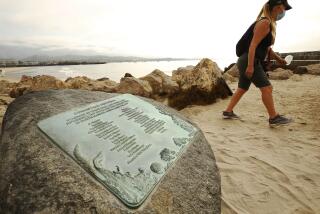Proposed Reforms Would Put Naval Yard Under OSHA : Safety: Under current law, the government does not fine itself, leaving the federal agency helpless to follow up on complaints of hazardous conditions.
When the Long Beach Naval Shipyard was cited three years ago for exposing its workers to more hazardous conditions than any of the nation’s seven other government-owned yards, the only real penalty it suffered was the public humiliation of embarrassing headlines.
The hundreds of workplace hazards discovered at the 48-year-old yard might have cost a private corporation tens of thousands of dollars in penalties. But under current law, the government does not fine itself, leaving the federal Occupational Safety and Health Administration powerless to do much more than paper errant agencies like the shipyard with complaints.
Although the yard’s safety record has improved markedly in recent years, union officials and federal workers have joined their counterparts from federal installations around the country in backing a package of proposed reform laws that would bring the federal worker under OSHA’s protective hand.
Citing powerful statistics of injury and death among federal employees, labor representatives from the eight shipyards and the National Aeronautics and Space Administration plan to stage a rally Monday at the U.S. Department of Labor in Washington to call for passage of the legislation now pending in Congress.
“It is estimated that 3,400 federal workers have lost their lives in work-related incidents. Nearly 30% of the people who died on the job worked for the Navy, which employs less than 12% of the total federal civilian work force,” a union flyer announced.
Those statistics span the 20 years since Congress acted to exclude government employees from OSHA protection. OSHA was ultimately empowered by President Jimmy Carter in 1980 to inspect government work sites, but not to issue citations or fines, leaving military shipyards and other government agencies to police themselves.
“It’s the case of the fox guarding the chickens,” said Louis Rodriguez, president of the shipyard’s International Federation of Professional and Technical Engineers Local 174. “Safety violations are noted by OSHA, but who is responsible for the follow-up?”
The safety record at the Long Beach yard has improved dramatically; officials report that the accident rate was down 79% between 1987 and 1990, with another 26% drop this year. A new safety director, better enforcement of work site regulations and extensive training raised the yard’s safety rating from unsatisfactory in 1988 to satisfactory in 1989, the highest possible mark.
Union leaders such as Rodriguez laud the shipyard for its renewed attention to safety. But, they note, some grisly accidents of years past--including one worker whose right hand was crushed in a metal-bending machine and another who lost three fingers in a punch press--might have been avoided had OSHA had more clout.
“The reason safety has improved at the Long Beach shipyard is because every year or so somebody raises hell,” said a shipyard safety activist who declined to be identified. “The Navy is paranoid about publicity . . . and our only legitimate weapon was to go to the newspapers. We were well aware that whenever something appeared in the paper, the accident rate would go down.”
Shipyard spokesman Jeff Gooding declined to comment on the package of bills, upon which even OSHA officials have yet to take a public stance.
Steven Hudson, supervisor of the OSHA San Diego office that oversees the Southern California region, said federal agencies have been quick to respond when inspectors point out a hazard.
“It’s rare that we don’t see (the system) work,” he said.
But many federal labor leaders agree that without the threat of fines, cost-conscious shipyards and other military facilities tend to weigh the price of repairing a hazard or shutting down a dangerous work site against the risk of human injury or death, argues James E. Sommerhauser, International Federation of Professional and Technical Engineers president in Washington.
The result has been a system of double standards that fails to protect the public employee, Sommerhauser said. He cited a recent case in which non-federal workers hired to replace a roof at an unnamed naval shipyard were given OSHA-required breathing apparatus while the federal shipyard workers on the top floor of the same building were given no equipment to protect them from lung-scarring fungus and bird droppings falling through the roof.
More to Read
Sign up for Essential California
The most important California stories and recommendations in your inbox every morning.
You may occasionally receive promotional content from the Los Angeles Times.









